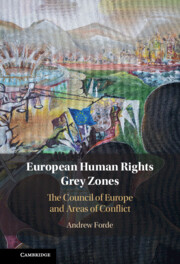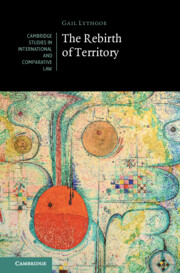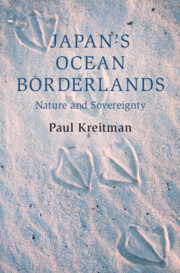332 results
Chapter 15 - Essay and Territory: The Geography of National Identity
- from Part II - Critical Inroads
-
-
- Book:
- A History of Argentine Literature
- Published online:
- 09 May 2024
- Print publication:
- 16 May 2024, pp 232-244
-
- Chapter
- Export citation
1 - Introduction
-
- Book:
- European Human Rights Grey Zones
- Published online:
- 18 April 2024
- Print publication:
- 25 April 2024, pp 1-19
-
- Chapter
- Export citation

European Human Rights Grey Zones
- The Council of Europe and Areas of Conflict
-
- Published online:
- 18 April 2024
- Print publication:
- 25 April 2024
3 - Excavating the Territory of International Law
-
- Book:
- The Rebirth of Territory
- Published online:
- 07 March 2024
- Print publication:
- 14 March 2024, pp 71-142
-
- Chapter
- Export citation
1 - Introduction
-
- Book:
- The Rebirth of Territory
- Published online:
- 07 March 2024
- Print publication:
- 14 March 2024, pp 1-29
-
- Chapter
-
- You have access
- HTML
- Export citation
4 - Re-imagining the Concept of Territory
-
- Book:
- The Rebirth of Territory
- Published online:
- 07 March 2024
- Print publication:
- 14 March 2024, pp 143-189
-
- Chapter
- Export citation

The Rebirth of Territory
-
- Published online:
- 07 March 2024
- Print publication:
- 14 March 2024
4 - The Khetem-Border-Posts in the Delta during the New Kingdom
-
-
- Book:
- The Nile Delta
- Published online:
- 15 February 2024
- Print publication:
- 22 February 2024, pp 158-184
-
- Chapter
- Export citation
2 - Call Me by My Names
-
-
- Book:
- The Nile Delta
- Published online:
- 15 February 2024
- Print publication:
- 22 February 2024, pp 68-104
-
- Chapter
- Export citation
7 - From Memphis to Alexandria
-
-
- Book:
- The Nile Delta
- Published online:
- 15 February 2024
- Print publication:
- 22 February 2024, pp 249-274
-
- Chapter
- Export citation
4 - Independence(s): What Is a Revolutionary Law?
-
-
- Book:
- The Cambridge History of Latin American Law in Global Perspective
- Published online:
- 15 January 2024
- Print publication:
- 08 February 2024, pp 250-282
-
- Chapter
-
- You have access
- Open access
- HTML
- Export citation
8 - The Relationship between Collective Self-Defence and Military Assistance on Request
-
- Book:
- Collective Self-Defence in International Law
- Published online:
- 04 January 2024
- Print publication:
- 25 January 2024, pp 276-311
-
- Chapter
- Export citation
Eradicating the exceptional: The role of territory in structuring international legal thought
-
- Journal:
- Leiden Journal of International Law , First View
- Published online by Cambridge University Press:
- 14 December 2023, pp. 1-18
-
- Article
-
- You have access
- Open access
- HTML
- Export citation
La despensa nacional: Quinoa and the Spatial Contradictions of Peru’s Gastronomic Revolution
-
- Journal:
- Latin American Research Review / Volume 59 / Issue 1 / March 2024
- Published online by Cambridge University Press:
- 11 December 2023, pp. 84-104
-
- Article
-
- You have access
- Open access
- HTML
- Export citation
Where has all the money gone? Materiality, mobility, and nothingness
-
- Journal:
- Finance and Society / Volume 1 / Issue 1 / 2015
- Published online by Cambridge University Press:
- 09 November 2023, pp. 7-19
-
- Article
-
- You have access
- Open access
- Export citation
1 - Nationality and Ethnicity in the Ancient Near East
- from Part i - The Politics of Ethnicity, Nationhood, and Belonging in the Settings of Classical Civilizations
-
-
- Book:
- The Cambridge History of Nationhood and Nationalism
- Published online:
- 27 October 2023
- Print publication:
- 09 November 2023, pp 11-30
-
- Chapter
- Export citation
Chapter 4 - Property and Legitimacy
-
- Book:
- Social Anarchism and the Rejection of Moral Tyranny
- Published online:
- 19 October 2023
- Print publication:
- 02 November 2023, pp 121-151
-
- Chapter
-
- You have access
- Open access
- HTML
- Export citation
5 - Stakes
- from Part I - Developing a Methodology
-
-
- Book:
- Conducting Research on Global Environmental Agreement-Making
- Published online:
- 07 August 2023
- Print publication:
- 10 August 2023, pp 74-90
-
- Chapter
- Export citation
1 - Bonins of Contention
-
- Book:
- Japan's Ocean Borderlands
- Published online:
- 06 July 2023
- Print publication:
- 27 July 2023, pp 21-53
-
- Chapter
- Export citation

Japan's Ocean Borderlands
- Nature and Sovereignty
-
- Published online:
- 06 July 2023
- Print publication:
- 27 July 2023



